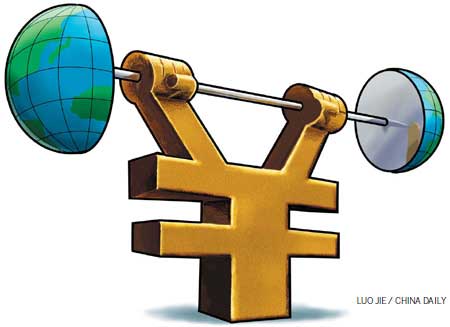Yuan influence should cross borders
By Zhang Ming (China Daily European Weekly) Updated: 2011-07-08 11:07Currency internationalization will help China reduce reliance on risky US debt
|
 |
The Chinese government has fastened the speed of promoting the yuan as a global settlement currency, alongside the dollar and the euro, especially after the financial crisis in 2008.
An international currency is used and held beyond the issuing country's borders, and plays the role of unit of account, medium of exchange, and store of value for residents and non-residents alike.
The Chinese government has taken several strategic steps to promote the yuan as an international currency. It started with promoting the yuan to be used in cross-border banking transactions, as a settlement currency for China's overseas direct investment and finally as an international reserve currency.
Total cross-border yuan settlement in the first half of last year hit 67 billion yuan (7 billion euros) and this figure went up to 467.8 billion yuan after the central bank expanded a pilot project allowing Chinese and foreign companies to settle trade transactions in yuan.
Thus far, China has made significant progress in the use of the yuan as a settlement currency, in the issuance of yuan-denominated bonds, and in signing currency-swap agreements with foreign central banks. Yuan deposits in Hong Kong are also growing exponentially.
The question is what are the strategic concerns of the Chinese government on its efforts to promote yuan internationalization? Certainly, there are many potential benefits for China from an internationalization of the yuan.
The outbreak of the US sub-prime mortgage crisis is the external factor that pushed the Chinese government to accelerate the internationalization of the yuan. Before the outbreak of the sub-prime crisis, the US dollar was considered a stable international reserve currency, and its national debt the most liquid-riskless asset.
The Chinese government has accumulated a lot of foreign exchange reserves through trade and foreign capital inflows. This shows that the Chinese government had a belief in US dollars and US treasuries. However, the sub-prime crisis has undermined the US dollar's and US treasuries' reputation for reliability.
The second quantitative easing measure has contributed to the depreciation of the dollar, and the continuation and deepening of the credit crisis in the US. Such a move entirely encroaches on the interests of the creditors, indicating the decline of the US government's intentions to repay its debt.
The US government has injected $2.8 trillion into the economy since 2008. Serious defects in the US economic development and management model have led to the long-term recession of its national economy, fundamentally lowering national solvency.
For the first time, credit ratings agency Standard & Poor's cut its outlook on US debt from "stable" to "negative" in April this year. A negative outlook means there is 33 percent chance that it will be downgraded again in the next two years.











